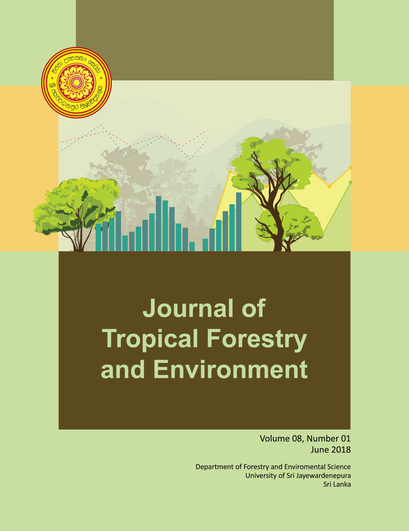Community and Industry Attitude Towardsusing Invasive Prosopisjulifloraas a Dry Matter Energy Sourcefor Small Scale Industries: A Case Study in Hambantota, Sri Lanka
DOI:
https://doi.org/10.31357/jtfe.v8i1.3484Abstract
Bundala is Sri Lanka’s first RAMSAR wetland declared under Ramsar Convention, and it has been declared as a national park in 1993 under Fauna and Flora Protection ordinance.At present, wide spread of P.juliflora in the Bundala National Park area has become a threat to diverse ecosystems, and the park management is removing substantial biomass of P. juliflora each year in an attempt to control this invasive species. As such, investigating the potential to utilize the removed biomass of P.juliflora has become important. This study was conducted with the objective of evaluating community and industry attitude and awareness of using P.juliflora as a dry matter energy source in Hambantota District. Two different questionnaires were used for two groups after pre testing in Ambalantota, Hambantota and Tissamaharama Divisional Secretariat Divisions. According to study findings, subsistence energy needs of community are basically fulfilled by common fuel wood species in the area such as Manilkarahexandra and Drypetessepiara. Community in the area is aware about the fast spread of P. juliflora over native species. Approximately 45% of study respondents represent brick industry and they often use rice husk ovens due to lack of firewood to be found in the area and the high availability of rice husk. Since industry and community prefer P.juliflora as a fuel, responsible agencies should make appropriate arrangements to harvest, process and make available the biomass to partially fulfill the thermal energy requirement in the area.
Key words: Prosopisjuliflora, small scale industries, Bundala National Park, dry matter energy source
Downloads
Published
How to Cite
Issue
Section
License
The publisher retain the copyrights of contents published, and all open access articles are distributed under the terms of the Creative Commons Attribution-Noncommercial-No Derivative Works 3.0 Unported License[U1], which permits unrestricted use, distribution and reproduction in any medium, provided that the original work is properly cited.
You can download the Legal Code for this License at: http://creativecommons.org/licenses/by-nc-nd/3.0/legalcode


